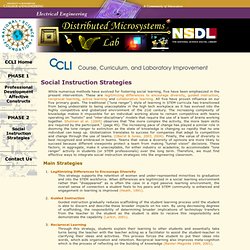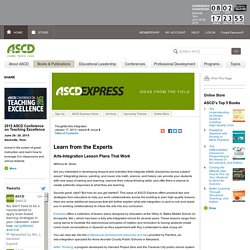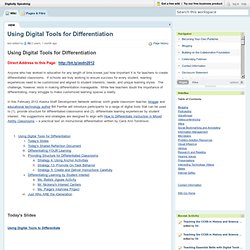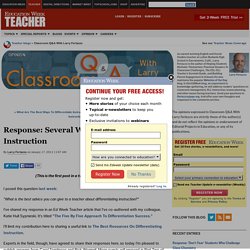

Q&A With The Authors of A New Culture of Learning. University of Washington - DMS Laboratory - CCLI Project - Social Instruction Strategies. While numerous methods have evolved for fostering social learning, five have been emphasized in the present intervention.

These are legitimizing differences to encourage diversity, guided instruction, reciprocal learning, active learning and collaborative learning. All five have proven influence on our five primary goals. The traditional ("lone ranger") style of learning in STEM curricula has transitioned from being undesirable to being unacceptable in the high tech workplace as it has evolved into the highly competitive and globalized environment of the 21st century. The increasing complexity of knowledge makes it impossible for an individual working alone to remain competitive with teams operating on "holistic" and "inter-disciplinary" models that require the use of a team of brains working together.
Shulman et al. (2005) observes that "the more complex the activity, the more team skills are required by the participant. " PBS LearningMedia. Express 8.08 - Learn from the Experts: Arts-Integration Lesson Plans That Work. Learn from the Experts Arts-Integration Lesson Plans That Work Willona M.

Sloan Are you interested in developing lessons and activities that integrate artistic disciplines across subject areas? Integrating dance, painting, and music into math, science, and history can provide your students with new ways of seeing and learning, improve their critical-thinking skills, and offer them a chance to create authentic responses to what they are learning. Sounds great, right? Edutopia offers a collection of lesson plans designed by educators at the Wiley H. You can also tap into the professional development resources and tips provided by Pat Klos, an arts-integration specialist for Anne Arundel County Public Schools in Maryland. Artful Thinking, a program developed by Harvard Project Zero and the Traverse City public school system in Michigan, provides a list of activities and lessons designed to teach students how to develop thinking dispositions that support thoughtful learning.
ELS: Educational Leadership Solutions. K-12 Academic and Culture Analytics Platform - Kickboard. Differentiation. Using Digital Tools for Differentiation. Direct Address to this Page: Anyone who has worked in education for any length of time knows just how important it is for teachers to create differentiated classrooms.

If schools are truly working to ensure success for every student, learning experiences need to be customized and aligned to student interests, needs, and unique learning styles. The challenge, however, rests in making differentiation manageable. While few teachers doubt the importance of differentiating, many struggle to make customized learning spaces a reality.
In this February 2012 Alaska Staff Development Network webinar, sixth grade classroom teacher, blogger and educational technology author Bill Ferriter will introduce participants to a range of digital tools that can be used to (1). provide structure for differentiated classrooms and (2). differentiate learning experiences by student interest. Today's Slides Today's Shared Reflection Document To access our shared written reflection document, click here. She writes: Apps for Teachers / Special Needs. Differentation in learning/ teaching. Response: Several Ways To Differentiate Instruction - Classroom Q&A With Larry Ferlazzo. (This is the first post in a two-part series on differentiation) I posed this question last week: "What is the best advice you can give to a teacher about differentiating instruction?

" I've shared my response in an Ed Week Teacher article that I've co-authored with my colleague, Katie Hull Sypnieski. It's titled "The Five By Five Approach To Differentiation Success. " I'll limit my contribution here to sharing a useful link to The Best Resources On Differentiating Instruction.
Experts in the field, though, have agreed to share their responses here, so today I'm pleased to publish answers from Carol Tomlinson and Rick Wormeli. Response From Carol Tomlinson Carol Tomlinson is an internationally-recognized leader and author in the field of differentiated instruction. The Best Resources On Differentiating Instruction. My colleague Katie Hull-Sypnieski is leading a February 1st Education Week Webinar on differentiating instruction, and I would strongly encourage people to participate.

Katie’s the best teacher I’ve ever seen…. In addition, Katie and I have co-authored a piece for Education Week Teacher on the topic that will be appearing there soon (it’s appeared: The Five By Five Approach To Differentiation Success), and an upcoming post in my blog there will be talking about it, too (that two part series has also appeared).
I also did a second two-part series in Ed Week on differentiation. Also, check out The Best “Fair Isn’t Equal” Visualizations. Dare to Differentiate - 50 Terrific Teacher Tips! Differentiation - tools, tips and resources. Differentiation is an important aspect of education.

Students learn differently, have different needs, different backgrounds, different skills, different ability levels, different interests and more. As educators, we try to create engaging lesson activities that provide a variety of learning experiences and allow students to demonstrate their learning in different ways. Differentiation should occur in both how students learn and gain knowledge and skills, and in how they demonstrate and are assessed on what they have learned. “In the practice of education, differentiation is defined as working to address the abilities, interests, and needs (both perceived and real) of individuals. Differentiation provides students with opportunities to approach curriculum from their strengths, as varied as these might be.”